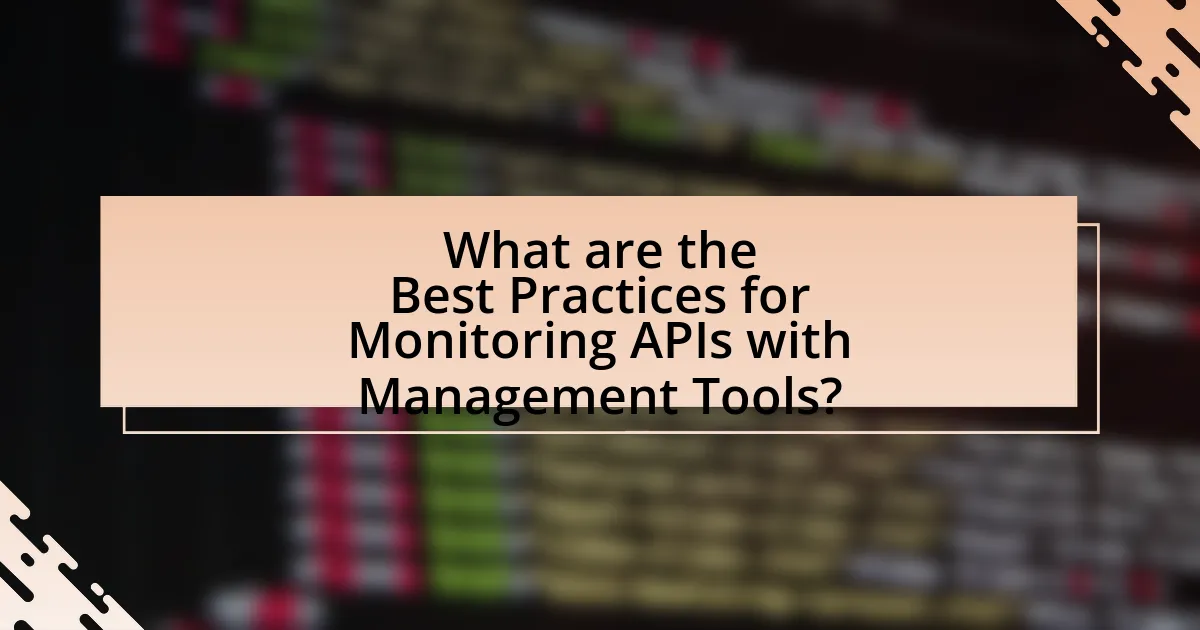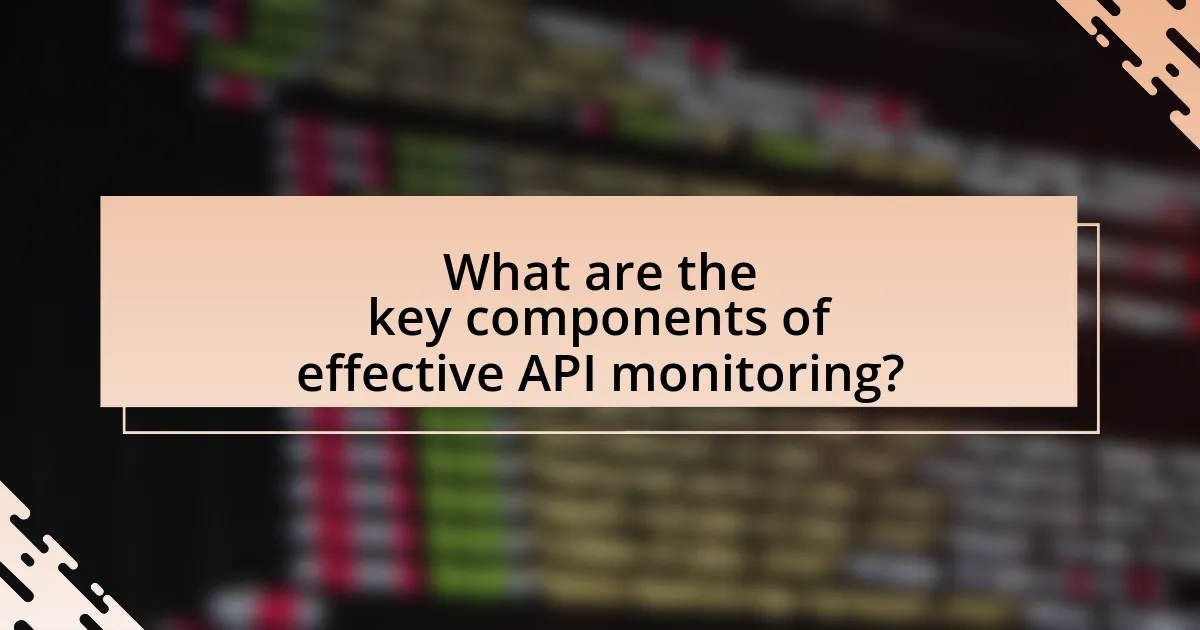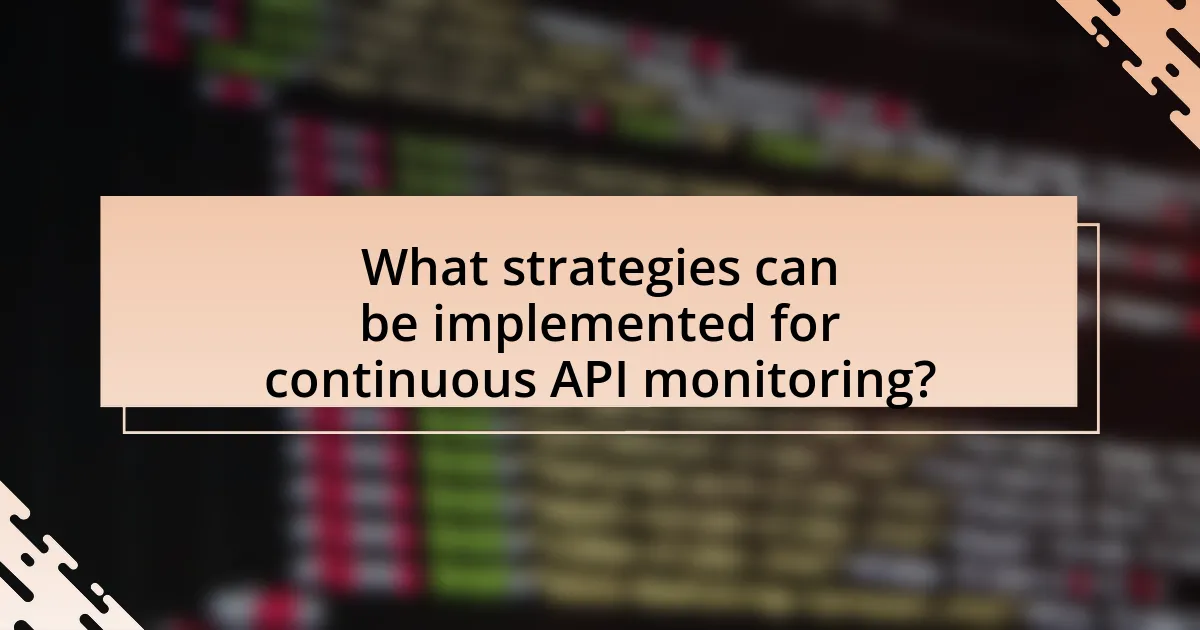The article focuses on best practices for monitoring APIs using management tools, emphasizing the importance of real-time monitoring, alert systems, and analytics for optimizing API performance. Key components discussed include the enhancement of monitoring capabilities through API management tools, the significance of comprehensive logging, and the role of alerting in maintaining service reliability. Additionally, the article outlines strategies for continuous monitoring, the impact of automated testing, and common pitfalls to avoid, highlighting the critical need for effective API oversight to mitigate risks such as downtime and security vulnerabilities.
What are the Best Practices for Monitoring APIs with Management Tools?

The best practices for monitoring APIs with management tools include implementing real-time monitoring, setting up alerts for performance thresholds, and utilizing analytics for usage patterns. Real-time monitoring allows for immediate detection of issues, ensuring that any downtime or performance degradation is addressed promptly. Setting alerts based on predefined performance thresholds helps in proactive management, allowing teams to respond before users are affected. Utilizing analytics provides insights into usage patterns, enabling optimization of API performance and resource allocation. These practices are supported by industry standards, such as the API Management Best Practices by the OpenAPI Initiative, which emphasizes the importance of monitoring for maintaining API reliability and performance.
How do API management tools enhance monitoring capabilities?
API management tools enhance monitoring capabilities by providing real-time analytics and performance metrics for APIs. These tools aggregate data from various endpoints, enabling organizations to track usage patterns, identify bottlenecks, and monitor response times effectively. For instance, tools like Apigee and AWS API Gateway offer dashboards that visualize API performance, allowing teams to quickly detect anomalies and troubleshoot issues. This capability is crucial for maintaining optimal API performance and ensuring a seamless user experience.
What features should be prioritized in API management tools for effective monitoring?
API management tools should prioritize real-time analytics, alerting mechanisms, and comprehensive logging for effective monitoring. Real-time analytics enable users to track API performance and usage patterns instantly, allowing for quick identification of issues. Alerting mechanisms notify stakeholders of anomalies or performance degradation, ensuring timely responses to potential problems. Comprehensive logging captures detailed information about API requests and responses, facilitating troubleshooting and performance optimization. These features collectively enhance visibility and control over API operations, leading to improved reliability and user satisfaction.
How do these features contribute to overall API performance?
API performance is significantly enhanced by features such as rate limiting, caching, and monitoring. Rate limiting prevents server overload by controlling the number of requests a user can make, ensuring consistent response times and resource availability. Caching reduces latency by storing frequently accessed data, allowing for quicker retrieval and less strain on backend systems. Monitoring tools provide real-time insights into API usage and performance metrics, enabling proactive identification of bottlenecks and issues. These features collectively ensure that APIs operate efficiently, maintain high availability, and deliver a better user experience.
Why is monitoring APIs crucial for businesses?
Monitoring APIs is crucial for businesses because it ensures optimal performance, reliability, and security of their services. By continuously tracking API usage and performance metrics, businesses can quickly identify and resolve issues that may disrupt service delivery. For instance, a study by Google Cloud found that 70% of organizations experienced downtime due to API failures, which can lead to significant revenue loss and damage to brand reputation. Therefore, effective API monitoring not only enhances user experience but also supports business continuity and operational efficiency.
What risks are associated with unmonitored APIs?
Unmonitored APIs pose significant risks, including security vulnerabilities, performance issues, and data breaches. Without monitoring, organizations cannot detect unauthorized access or anomalies in API usage, which can lead to exploitation by malicious actors. Additionally, unmonitored APIs may experience performance degradation, resulting in slow response times or downtime, negatively impacting user experience. According to a report by the API Security Project, 94% of organizations have experienced an API security incident, highlighting the critical need for monitoring to mitigate these risks effectively.
How can effective monitoring improve API reliability and user experience?
Effective monitoring enhances API reliability and user experience by enabling real-time detection of issues and performance bottlenecks. This proactive approach allows developers to identify and resolve problems before they impact users, ensuring consistent service availability. For instance, according to a study by Google, 53% of mobile users abandon apps that take longer than three seconds to load, highlighting the importance of timely issue resolution. By utilizing monitoring tools that provide insights into API performance metrics, such as response times and error rates, organizations can make data-driven decisions to optimize their APIs, ultimately leading to improved user satisfaction and retention.
What are the key components of effective API monitoring?

The key components of effective API monitoring include performance metrics, error tracking, security monitoring, and user experience analysis. Performance metrics involve tracking response times, throughput, and latency to ensure APIs meet service level agreements. Error tracking focuses on identifying and logging errors to facilitate quick resolution, while security monitoring assesses vulnerabilities and unauthorized access attempts. User experience analysis evaluates how end-users interact with the API, providing insights into usability and satisfaction. These components collectively ensure that APIs function optimally and securely, enhancing overall service quality.
How can logging and analytics improve API monitoring?
Logging and analytics enhance API monitoring by providing real-time insights into API performance and usage patterns. These tools enable developers to track metrics such as response times, error rates, and request volumes, allowing for immediate identification of issues. For instance, a study by Google Cloud found that organizations utilizing logging and analytics can reduce downtime by up to 50% through proactive monitoring and troubleshooting. This data-driven approach not only improves operational efficiency but also aids in optimizing API design and user experience.
What types of data should be logged for optimal monitoring?
For optimal monitoring, the types of data that should be logged include request and response times, error rates, user activity, system performance metrics, and API usage statistics. Logging request and response times helps identify latency issues, while tracking error rates allows for quick detection of failures. User activity logs provide insights into how the API is being utilized, and system performance metrics, such as CPU and memory usage, help assess the health of the infrastructure. API usage statistics, including the number of calls and endpoints accessed, inform capacity planning and optimization efforts. Collectively, these data types enable comprehensive monitoring and facilitate proactive management of API performance.
How can analytics tools help in identifying API performance issues?
Analytics tools can help in identifying API performance issues by providing real-time monitoring and detailed metrics on API usage, response times, and error rates. These tools collect data on various performance indicators, such as latency, throughput, and the number of requests, allowing developers to pinpoint bottlenecks and inefficiencies. For instance, a study by Google Cloud found that monitoring tools can reduce API response times by up to 30% when performance issues are identified and addressed promptly. By analyzing trends over time, analytics tools also enable teams to anticipate potential issues before they escalate, ensuring optimal API performance.
What role does alerting play in API monitoring?
Alerting plays a critical role in API monitoring by providing timely notifications about performance issues, errors, or downtime. This functionality enables teams to respond quickly to incidents, minimizing potential disruptions to services. For instance, according to a study by the IT service management firm PagerDuty, organizations that implement effective alerting mechanisms can reduce incident response times by up to 50%. This demonstrates that alerting not only enhances operational efficiency but also improves overall service reliability.
What are the best practices for setting up alerts?
The best practices for setting up alerts include defining clear alert criteria, prioritizing alerts based on severity, and ensuring alerts are actionable. Clear criteria help in identifying specific conditions that trigger alerts, such as response time thresholds or error rates. Prioritizing alerts ensures that critical issues are addressed first, reducing alert fatigue. Actionable alerts provide specific guidance on how to resolve the issue, which enhances response efficiency. According to a study by the IT Service Management Forum, organizations that implement these practices experience a 30% reduction in response times to incidents.
How can alerts be tailored to different stakeholders?
Alerts can be tailored to different stakeholders by customizing the content, frequency, and delivery method based on their specific roles and needs. For instance, technical teams may require detailed alerts with metrics and logs, while executive stakeholders might prefer high-level summaries that highlight key performance indicators. Additionally, alerts can be configured to trigger based on specific thresholds relevant to each stakeholder’s responsibilities, ensuring that the information is pertinent and actionable. This approach enhances the relevance of the alerts, leading to more effective monitoring and quicker response times.
What strategies can be implemented for continuous API monitoring?

Continuous API monitoring can be implemented through strategies such as automated health checks, performance tracking, and anomaly detection. Automated health checks involve regularly sending requests to the API endpoints to verify their availability and response times, ensuring that any downtime is quickly identified. Performance tracking measures key metrics like latency, throughput, and error rates, allowing teams to assess the API’s efficiency and user experience. Anomaly detection utilizes machine learning algorithms to identify unusual patterns in API usage, which can indicate potential issues or security threats. These strategies collectively enhance the reliability and performance of APIs, as evidenced by studies showing that proactive monitoring can reduce downtime by up to 50%.
How can automated testing enhance API monitoring efforts?
Automated testing enhances API monitoring efforts by providing consistent and repeatable validation of API functionality and performance. This consistency allows teams to quickly identify issues such as response time degradation or functional failures, which can be critical for maintaining service reliability. For instance, automated tests can be scheduled to run at regular intervals, ensuring that any deviations from expected behavior are detected promptly. Additionally, automated testing frameworks can integrate with monitoring tools, enabling real-time alerts and detailed reporting on API health. This integration not only streamlines the monitoring process but also reduces the manual effort required, allowing teams to focus on resolving issues rather than identifying them.
What types of automated tests are most effective for APIs?
The most effective types of automated tests for APIs are unit tests, integration tests, and end-to-end tests. Unit tests validate individual components of the API, ensuring that each function behaves as expected. Integration tests assess the interaction between different components or services, confirming that they work together correctly. End-to-end tests simulate user scenarios to verify that the entire API workflow functions as intended. These testing types are essential because they help identify issues early in the development process, reduce bugs in production, and enhance overall API reliability.
How frequently should automated tests be conducted?
Automated tests should be conducted at least once per build cycle, ideally with every code change. This frequency ensures that any new code does not introduce regressions or bugs, maintaining the integrity of the application. Continuous Integration (CI) practices support this approach, as they automate the testing process with each commit, allowing for immediate feedback on code quality. Studies show that teams practicing frequent automated testing experience up to 30% fewer defects in production, highlighting the effectiveness of this strategy in maintaining software reliability.
What are the best practices for integrating monitoring tools with existing workflows?
The best practices for integrating monitoring tools with existing workflows include ensuring compatibility, automating data collection, and establishing clear communication channels. Compatibility between monitoring tools and existing systems is crucial to avoid disruptions; for instance, using APIs that facilitate seamless data exchange can enhance integration. Automating data collection minimizes manual intervention, which reduces errors and saves time, as evidenced by studies showing that automation can increase operational efficiency by up to 30%. Establishing clear communication channels among teams ensures that insights from monitoring tools are effectively shared and acted upon, leading to quicker response times and improved system reliability.
How can teams ensure seamless integration of monitoring tools?
Teams can ensure seamless integration of monitoring tools by adopting standardized protocols and APIs for communication between systems. Utilizing common frameworks such as REST or GraphQL allows for consistent data exchange, which enhances compatibility among various monitoring tools. Additionally, implementing automation scripts for deployment and configuration can streamline the integration process, reducing manual errors and improving efficiency. Research indicates that organizations employing standardized integration practices experience a 30% reduction in setup time for monitoring tools, leading to faster deployment and improved operational performance.
What challenges might arise during integration, and how can they be addressed?
Challenges during integration include data inconsistency, compatibility issues, and security vulnerabilities. Data inconsistency arises when different systems use varying formats or standards, which can be addressed by implementing data transformation protocols and ensuring uniform data models across platforms. Compatibility issues often occur when integrating legacy systems with modern APIs; these can be mitigated by using middleware solutions that facilitate communication between disparate systems. Security vulnerabilities may emerge due to inadequate authentication and authorization processes; addressing this requires implementing robust security measures such as OAuth for secure access and regular security audits to identify and rectify potential weaknesses.
What are the common pitfalls to avoid in API monitoring?
Common pitfalls to avoid in API monitoring include neglecting to define clear performance metrics, failing to monitor all endpoints, and not setting up alerts for anomalies. Defining performance metrics is crucial because it allows teams to measure API efficiency and user experience accurately. Monitoring all endpoints ensures that potential issues are identified across the entire API landscape, rather than just the most frequently used paths. Additionally, setting up alerts for anomalies helps in proactive issue resolution, preventing downtime and maintaining service reliability. These practices are essential for effective API management and can significantly enhance overall system performance.
How can over-monitoring negatively impact performance?
Over-monitoring can negatively impact performance by creating unnecessary stress and anxiety among employees, which can lead to decreased productivity. When individuals feel they are constantly being watched, it can result in a lack of autonomy and creativity, as they may focus more on meeting monitoring criteria rather than engaging in innovative problem-solving. Research indicates that excessive surveillance can lead to burnout, with a study published in the Journal of Occupational Health Psychology showing that employees subjected to high levels of monitoring reported lower job satisfaction and higher turnover intentions. This evidence underscores the detrimental effects of over-monitoring on overall performance and workplace morale.
What are the consequences of under-monitoring APIs?
Under-monitoring APIs can lead to significant operational risks, including increased downtime, security vulnerabilities, and poor user experience. When APIs are not adequately monitored, issues such as performance degradation or outages may go unnoticed, resulting in service interruptions that can affect business operations and customer satisfaction. Additionally, the lack of monitoring can allow security breaches to occur without detection, exposing sensitive data and leading to potential legal and financial repercussions. According to a 2021 report by the API Security Project, 90% of organizations experienced at least one API security incident due to insufficient monitoring practices, highlighting the critical need for robust API oversight.
What practical tips can enhance API monitoring effectiveness?
To enhance API monitoring effectiveness, implement comprehensive logging to capture detailed request and response data. This practice allows for better troubleshooting and performance analysis, as it provides insights into API usage patterns and error occurrences. Additionally, setting up alerts for specific thresholds, such as response time or error rates, ensures timely notifications of potential issues, enabling proactive resolution. Utilizing monitoring tools that offer real-time analytics can further improve visibility into API performance, allowing teams to make data-driven decisions. According to a survey by SmartBear, 90% of organizations that implemented robust API monitoring reported improved application performance and user satisfaction.